2006 KIA CERATO warning light
[x] Cancel search: warning lightPage 30 of 315
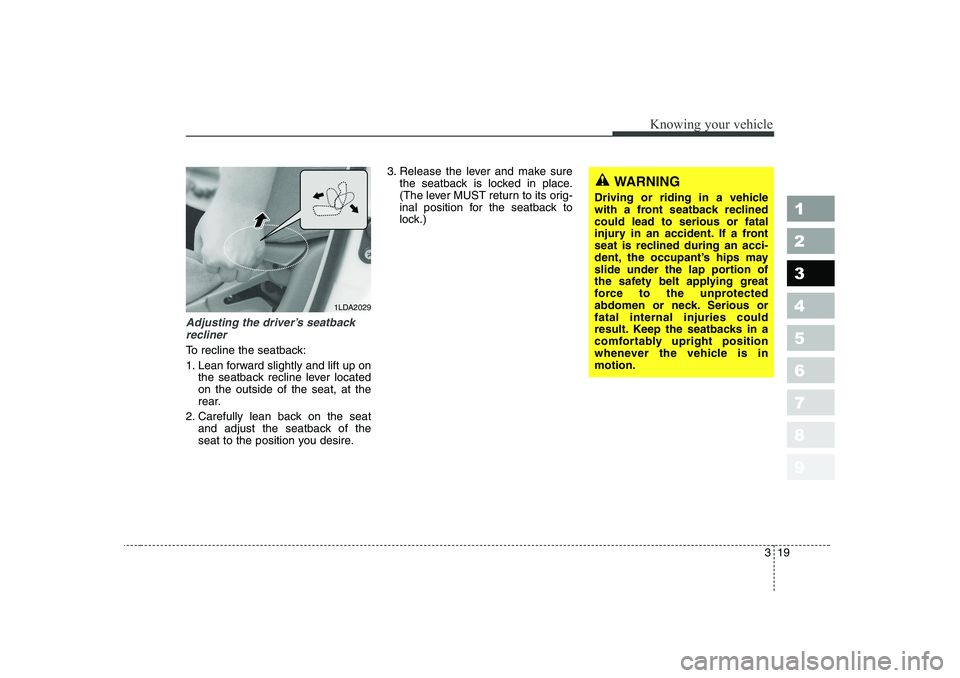
319
1 23456789
Knowing your vehicle
Adjusting the driver’s seatbackrecliner
To recline the seatback:
1. Lean forward slightly and lift up on the seatback recline lever located on the outside of the seat, at the
rear.
2. Carefully lean back on the seat and adjust the seatback of the
seat to the position you desire. 3. Release the lever and make sure
the seatback is locked in place.
(The lever MUST return to its orig-
inal position for the seatback to
lock.)
1LDA2029
WARNING
Driving or riding in a vehicle
with a front seatback reclinedcould lead to serious or fatal
injury in an accident. If a front
seat is reclined during an acci-
dent, the occupant’s hips may
slide under the lap portion of
the safety belt applying great
force to the unprotected
abdomen or neck. Serious orfatal internal injuries could
result. Keep the seatbacks in a
comfortably upright position
whenever the vehicle is inmotion.
Page 34 of 315
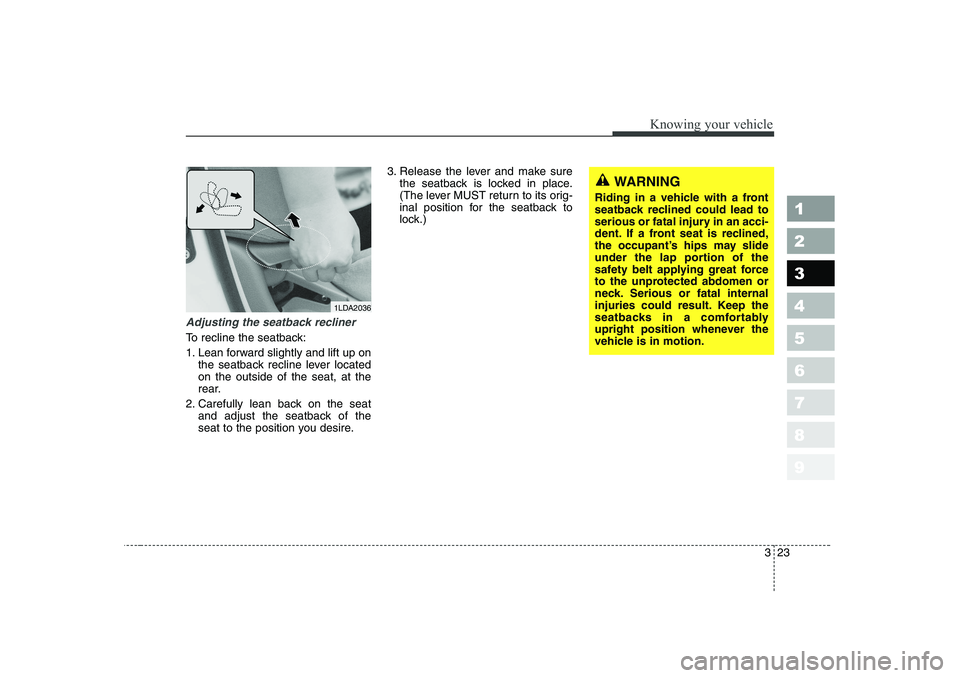
323
1 23456789
Knowing your vehicle
Adjusting the seatback recliner
To recline the seatback:
1. Lean forward slightly and lift up onthe seatback recline lever located on the outside of the seat, at the
rear.
2. Carefully lean back on the seat and adjust the seatback of the
seat to the position you desire. 3. Release the lever and make sure
the seatback is locked in place.
(The lever MUST return to its orig-
inal position for the seatback to
lock.)
WARNING
Riding in a vehicle with a front
seatback reclined could lead to
serious or fatal injury in an acci-
dent. If a front seat is reclined,
the occupant’s hips may slide
under the lap portion of the
safety belt applying great force
to the unprotected abdomen or
neck. Serious or fatal internal
injuries could result. Keep the
seatbacks in a comfortably
upright position whenever the
vehicle is in motion.
1LDA2036
Page 41 of 315
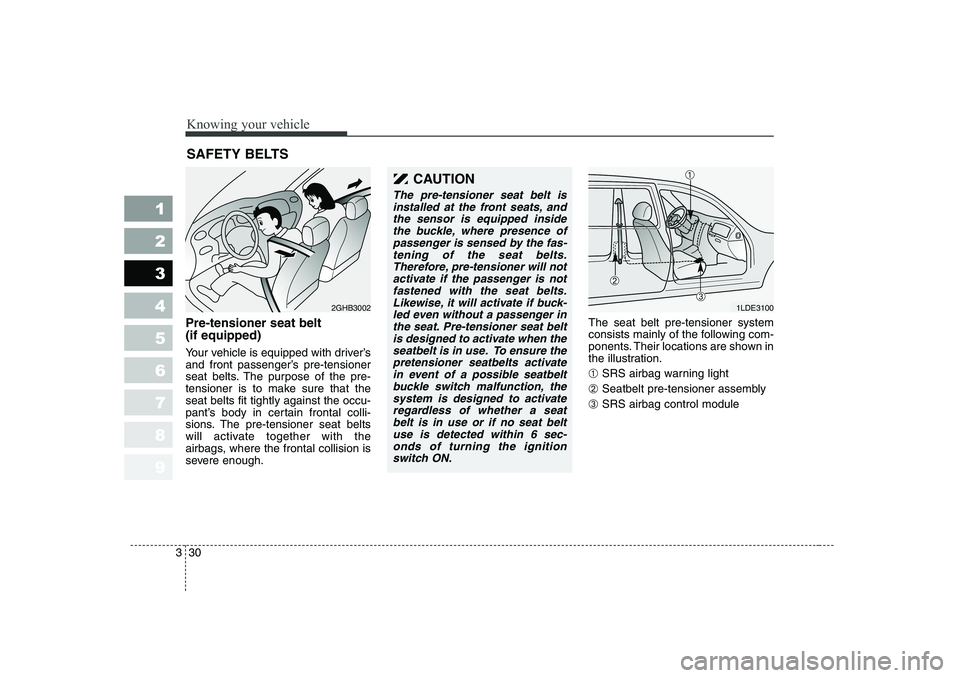
Knowing your vehicle
30
3
1 23456789
Pre-tensioner seat belt (if equipped)
Your vehicle is equipped with driver’s
and front passenger’s pre-tensioner
seat belts. The purpose of the pre-
tensioner is to make sure that theseat belts fit tightly against the occu-
pant’s body in certain frontal colli-
sions. The pre-tensioner seat belts
will activate together with the
airbags, where the frontal collision is
severe enough. The seat belt pre-tensioner system
consists mainly of the following com-
ponents. Their locations are shown in
the illustration. ➀
SRS airbag warning light
➁ Seatbelt pre-tensioner assembly
➂ SRS airbag control module
SAFETY BELTS
2GHB3002
CAUTION
The pre-tensioner seat belt is
installed at the front seats, andthe sensor is equipped insidethe buckle, where presence of passenger is sensed by the fas-tening of the seat belts.Therefore, pre-tensioner will not activate if the passenger is notfastened with the seat belts.Likewise, it will activate if buck- led even without a passenger inthe seat. Pre-tensioner seat beltis designed to activate when theseatbelt is in use. To ensure the pretensioner seatbelts activatein event of a possible seatbeltbuckle switch malfunction, the system is designed to activateregardless of whether a seatbelt is in use or if no seat belt use is detected within 6 sec-onds of turning the ignitionswitch ON.
1LDE3100
➀
➁
➂
Page 42 of 315
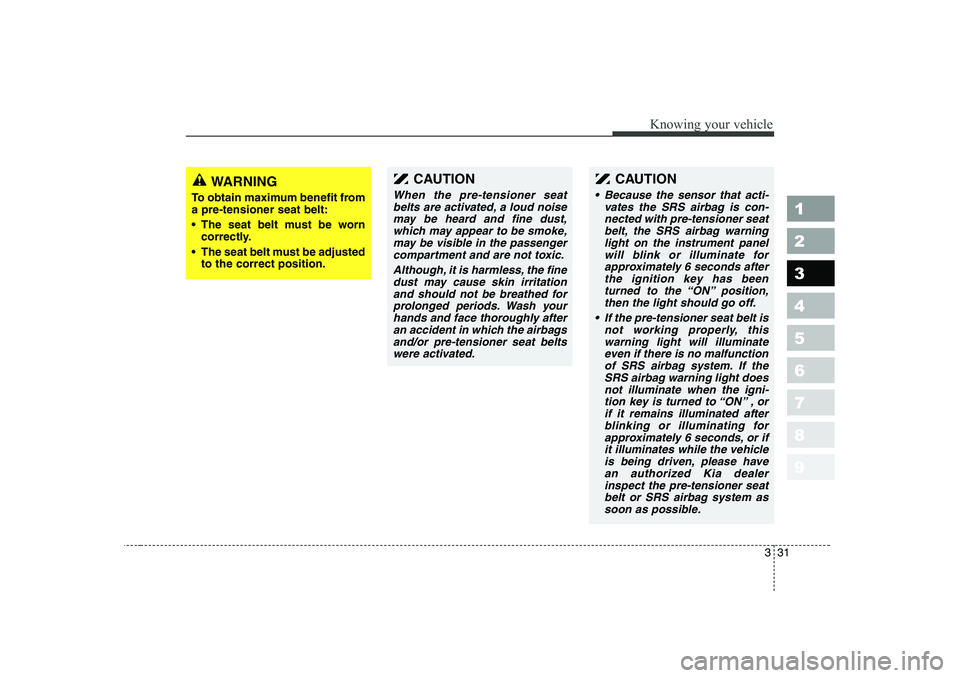
331
1 23456789
Knowing your vehicle
WARNING
To obtain maximum benefit from a pre-tensioner seat belt:
The seat belt must be worn correctly.
The seat belt must be adjusted to the correct position.CAUTION
When the pre-tensioner seat
belts are activated, a loud noise may be heard and fine dust,which may appear to be smoke,may be visible in the passenger compartment and are not toxic.
Although, it is harmless, the finedust may cause skin irritationand should not be breathed forprolonged periods. Wash your hands and face thoroughly afteran accident in which the airbagsand/or pre-tensioner seat belts were activated.
CAUTION
Because the sensor that acti- vates the SRS airbag is con-nected with pre-tensioner seatbelt, the SRS airbag warninglight on the instrument panel will blink or illuminate forapproximately 6 seconds afterthe ignition key has beenturned to the “ON” position, then the light should go off.
If the pre-tensioner seat belt is not working properly, thiswarning light will illuminateeven if there is no malfunction of SRS airbag system. If theSRS airbag warning light doesnot illuminate when the igni- tion key is turned to “ON” , orif it remains illuminated afterblinking or illuminating for approximately 6 seconds, or ifit illuminates while the vehicleis being driven, please have an authorized Kia dealerinspect the pre-tensioner seatbelt or SRS airbag system as soon as possible.
Page 45 of 315
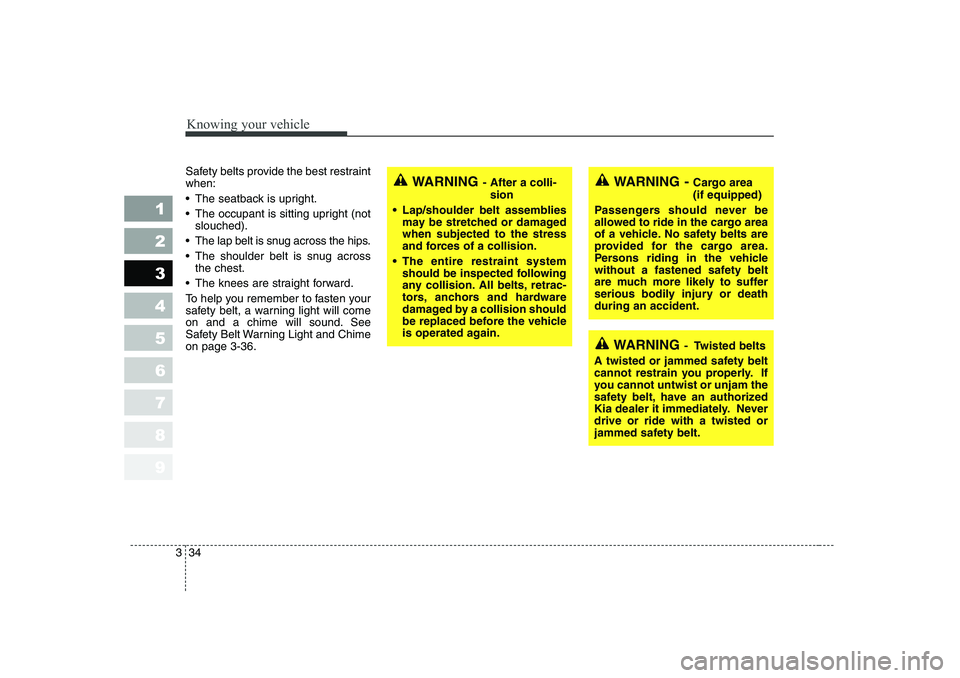
Knowing your vehicle
34
3
1 23456789
Safety belts provide the best restraint when:
The seatback is upright.
The occupant is sitting upright (not
slouched).
The lap belt is snug across the hips.
The shoulder belt is snug across the chest.
The knees are straight forward.
To help you remember to fasten your
safety belt, a warning light will come
on and a chime will sound. See
Safety Belt Warning Light and Chimeon page 3-36.WARNING - After a colli-
sion
Lap/shoulder belt assemblies may be stretched or damaged when subjected to the stress
and forces of a collision.
The entire restraint system should be inspected following
any collision. All belts, retrac-
tors, anchors and hardware
damaged by a collision should
be replaced before the vehicle
is operated again.WARNING - Cargo area (if equipped)
Passengers should never be
allowed to ride in the cargo area
of a vehicle. No safety belts are
provided for the cargo area.
Persons riding in the vehicle
without a fastened safety belt
are much more likely to suffer
serious bodily injury or deathduring an accident.
WARNING - Twisted belts
A twisted or jammed safety belt
cannot restrain you properly. If
you cannot untwist or unjam the
safety belt, have an authorized
Kia dealer it immediately. Neverdrive or ride with a twisted or
jammed safety belt.
Page 47 of 315
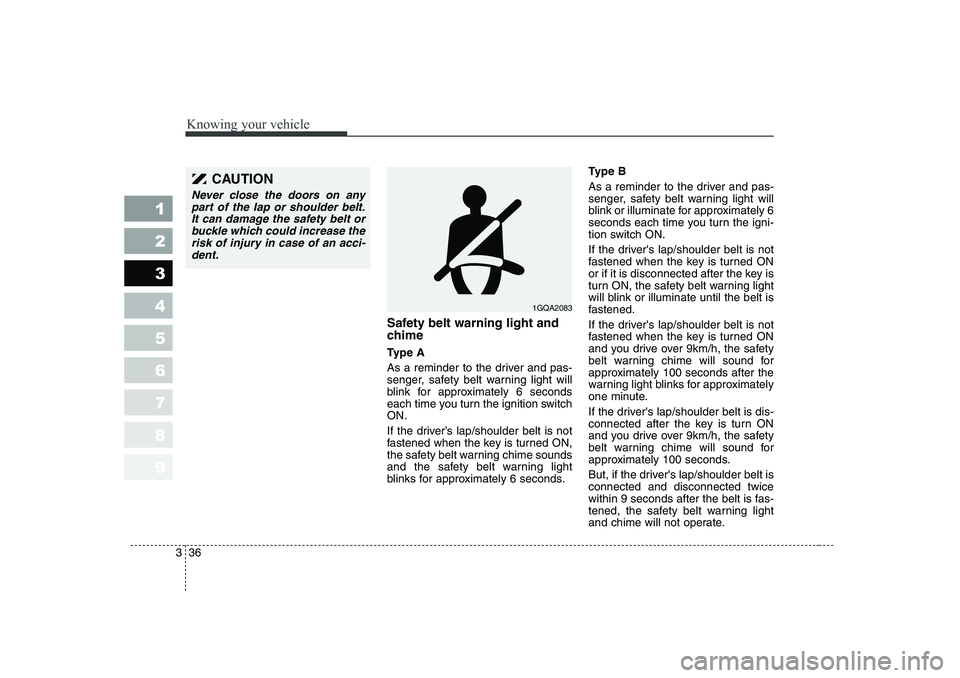
Knowing your vehicle
36
3
1 23456789
Safety belt warning light and
chime
Type A
As a reminder to the driver and pas-
senger, safety belt warning light will
blink for approximately 6 seconds
each time you turn the ignition switchON.
If the driver’s lap/shoulder belt is not
fastened when the key is turned ON,
the safety belt warning chime sounds
and the safety belt warning light
blinks for approximately 6 seconds. Type B
As a reminder to the driver and pas-
senger, safety belt warning light will
blink or illuminate for approximately 6
seconds each time you turn the igni-
tion switch ON.
If the driver's lap/shoulder belt is not
fastened when the key is turned ON
or if it is disconnected after the key is
turn ON, the safety belt warning light
will blink or illuminate until the belt is
fastened.
If the driver's lap/shoulder belt is not
fastened when the key is turned ON
and you drive over 9km/h, the safety
belt warning chime will sound for
approximately 100 seconds after the
warning light blinks for approximately
one minute.
If the driver's lap/shoulder belt is dis-
connected after the key is turn ON
and you drive over 9km/h, the safety
belt warning chime will sound for
approximately 100 seconds.
But, if the driver's lap/shoulder belt is connected and disconnected twice
within 9 seconds after the belt is fas-
tened, the safety belt warning light
and chime will not operate.
1GQA2083
CAUTION
Never close the doors on any
part of the lap or shoulder belt. It can damage the safety belt orbuckle which could increase therisk of injury in case of an acci- dent.
Page 58 of 315
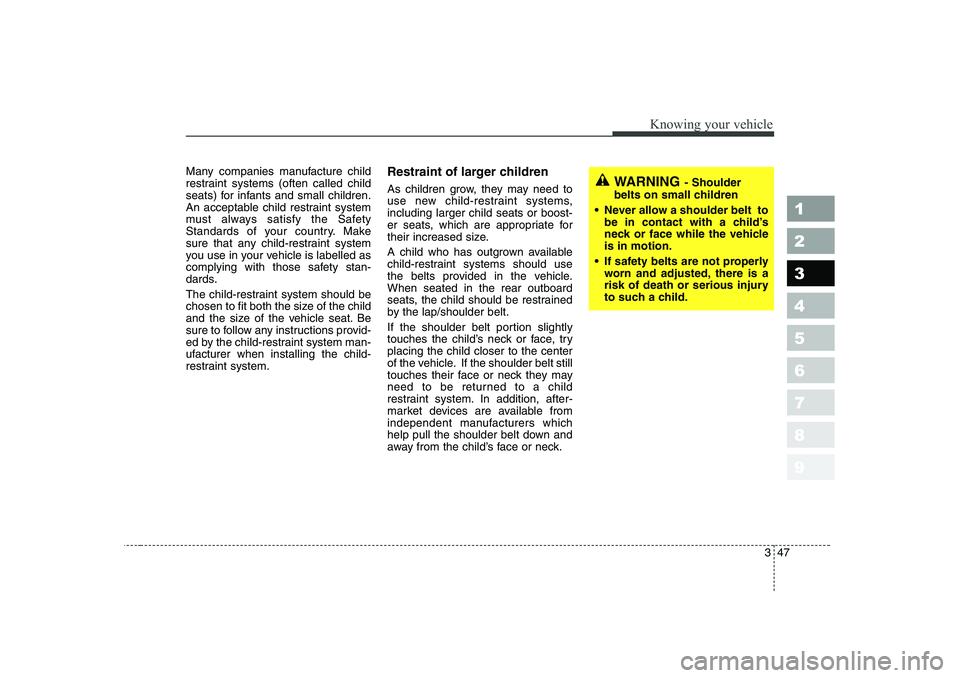
347
1 23456789
Knowing your vehicle
Many companies manufacture child
restraint systems (often called child
seats) for infants and small children.
An acceptable child restraint system
must always satisfy the Safety
Standards of your country. Make
sure that any child-restraint system
you use in your vehicle is labelled as
complying with those safety stan-
dards.
The child-restraint system should be
chosen to fit both the size of the child
and the size of the vehicle seat. Be
sure to follow any instructions provid-
ed by the child-restraint system man-
ufacturer when installing the child-
restraint system.Restraint of larger children
As children grow, they may need to
use new child-restraint systems,including larger child seats or boost-
er seats, which are appropriate for
their increased size.
A child who has outgrown available
child-restraint systems should use
the belts provided in the vehicle.When seated in the rear outboard
seats, the child should be restrained
by the lap/shoulder belt.
If the shoulder belt portion slightly
touches the child’s neck or face, tryplacing the child closer to the center
of the vehicle. If the shoulder belt still
touches their face or neck they may
need to be returned to a child
restraint system. In addition, after-
market devices are available from
independent manufacturers which
help pull the shoulder belt down and
away from the child’s face or neck.WARNING
- Shoulder
belts on small children
Never allow a shoulder belt to be in contact with a child’s
neck or face while the vehicleis in motion.
If safety belts are not properly worn and adjusted, there is a
risk of death or serious injury
to such a child.
Page 68 of 315
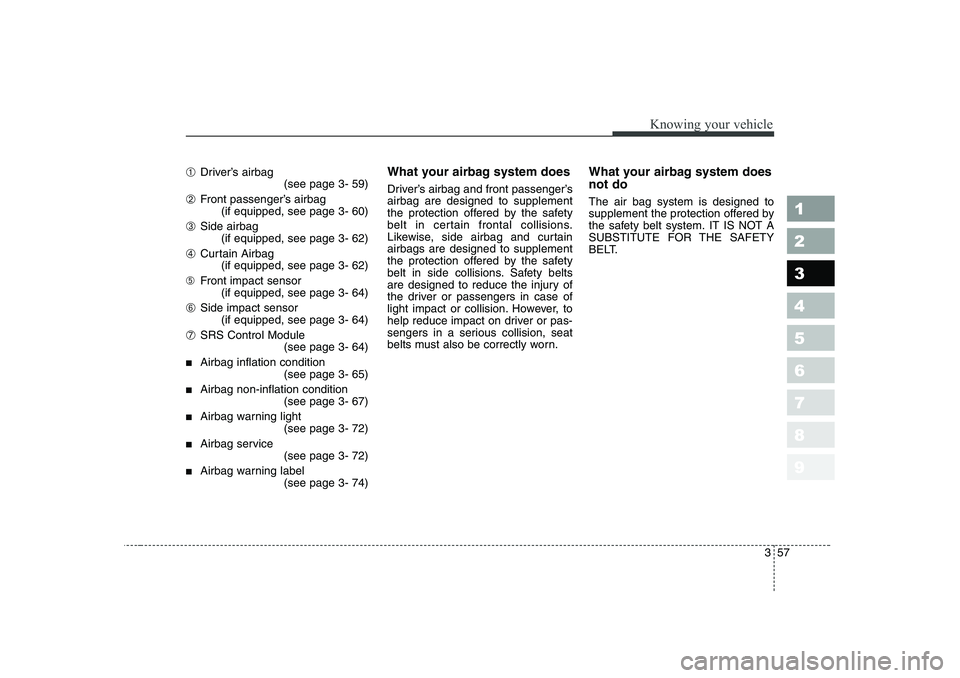
357
1 23456789
Knowing your vehicle
➀Driver’s airbag
(see page 3- 59)
➁ Front passenger’s airbag
(if equipped, see page 3- 60)
➂ Side airbag
(if equipped, see page 3- 62)
➃ Curtain Airbag
(if equipped, see page 3- 62)
➄ Front impact sensor
(if equipped, see page 3- 64)
➅ Side impact sensor
(if equipped, see page 3- 64)
➆ SRS Control Module
(see page 3- 64)
■ Airbag inflation condition
(see page 3- 65)
■ Airbag non-inflation condition
(see page 3- 67)
■ Airbag warning light
(see page 3- 72)
■ Airbag service
(see page 3- 72)
■ Airbag warning label
(see page 3- 74) What your airbag system does
Driver’s airbag and front passenger’s airbag are designed to supplement
the protection offered by the safety
belt in certain frontal collisions.
Likewise, side airbag and curtainairbags are designed to supplement
the protection offered by the safety
belt in side collisions. Safety belts
are designed to reduce the injury of
the driver or passengers in case of
light impact or collision. However, to
help reduce impact on driver or pas-
sengers in a serious collision, seat
belts must also be correctly worn.
What your airbag system does not do The air bag system is designed to
supplement the protection offered by
the safety belt system. IT IS NOT A
SUBSTITUTE FOR THE SAFETY
BELT.